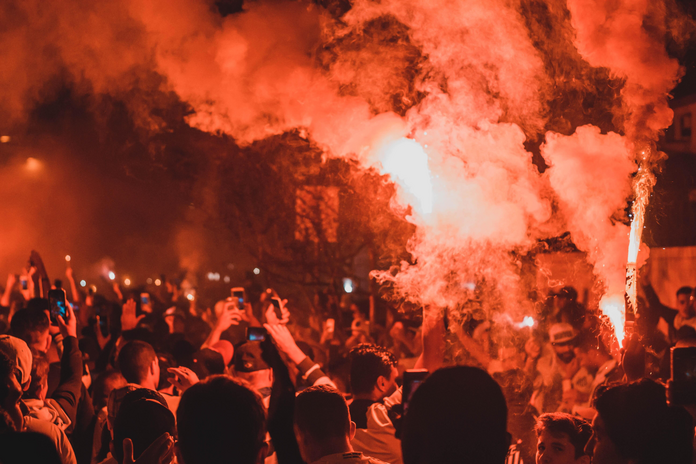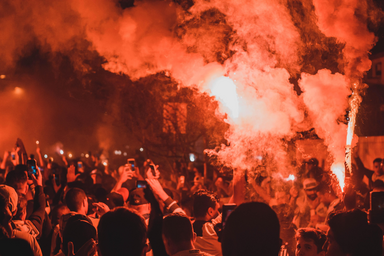Edited by: Pallavi NB
Pride’s New Frontier – New York City Cops
With the reckoning of Pride Month in New York City, one of the biggest metropolises on the planet to host a Pride event, the city has officially banned uniformed police officers from attending and policing the event. This is a move that stands with the very spirit of Pride – to be anti-cop and to push for LGBTQ+ self-determination. Pride is about pushing back from governments that pretend to care, and predatory corporate practices. When the local government of NYC keeps the police at least a block away from the main festivities of Pride, they invest resources into community-based security and first responders, highlighting the self-reliance and independence of the community. With this historic move, we must remember that the police have always cast a shadow on Pride with their shows of harassment, abuse of power, and institutionalised homophobia.
For the longest time, enforced city-based policing and regulation of Pride events comes from 2 things.
- The need to contain perceived obscenity (the homophobic notion that Pride is inherently a display of kinks), and
- The idea that the LGBTQ+ community is weak, easily harassed, and needs to be protected for its own good, i.e., that the community can’t defend itself.
In the face of this, we must remember that Pride is about debunking what people in City Hall think about the community — the essence of Pride is a show of strength. From its origins in the Stonewall Riots that pushed the cops back to iconic community leaders like Storme DeLarverie, Pride is about the community standing for its own and standing up.
Pride As a Revolution – The Politics and Violence of the White Night Riots
One of the landmark moments of such LGBTQ+ community strength was shown to the world in the White Night Riots of San Francisco on May 21st, 1979. After centuries of queer individualisation being relegated to the sidelines and being the object of sodomy and indecency trials of conservatives, the moments for social progress in the 1970s saw a sweeping change. For the first time in history, an openly gay official was elected to public office. With Harvey Milk, aka the Mayor of Castro Street, serving on the city’s Board of Supervisors, LGBTQ+ rights, solidarity, and agitation stepped into the spotlight of mainstream politics with the support of George Moscone as mayor. Harvey Milk’s activism may as well have been the flash-point of gay rights activism as we have it today. He pushed back against San Francisco’s aggressive arresting of members of the community for sodomy and indecency, appealing to the local Catholic conservatives and the Archdiocese with ties to the local government.
When Milk signed into law a bill that outlawed discrimination in housing and employment on the basis of sexual orientation and other backgrounds, Dan White, another (former) supervisor on the board and ex-cop, assassinated both him and Mayor Moscone. Despite this, Dan White was only convicted of voluntary manslaughter. He ridiculously claimed that eating Twinkies had made him insane, appealing to the conservative Catholic jury. In the 1970s, when the queer community had been a victim of judicial and police injustice, the city’s overwhelmingly gay and historic Castro Street residents would not stand for the verdict.
With the White Night Riots, 5,000 of San Francisco’s gay community peacefully marched to City Hall in silent anger. The police would not have it, supporting the network of violence that cops had on the gay community and standing in solidarity with White. While the police taped over their badges and caned the procession, the gays of Castro Street stood their ground in a revolutionary act not seen since the Stonewall Riots. The ensuing anti-police push-back they created injured 59 policemen, destroyed over a dozen patrol cars, and annihilated half of City Hall. On that day, the message sent by the queer community of San Francisco was loud and clear — they were no longer at the whim of brutal police force and a government that did not represent them.
Taking Action and Finding Pride – The Legacy of Milk
Looking back at the tale of the White Night Riots and the rise and fall of Harvey Milk, we have many takeaways and a part of queer history to be proud of. Harvey Milk showed us that with the introduction of queer politicians with queer-oriented politics, the neighbourhood would be a better place for everyone. He fulfilled his vision of having a world where the LGBTQ+ community wouldn’t have to hide in the shadows, in shame and fear of persecution. Milk showed the queer community that by being publicly proud of their identities and stepping into the spotlight, real change could be achieved, and oppressors could be suppressed. Milk took action and organized his community’s efforts into something greater. We can see one of the finest examples of queer independence and initiative here. Not relying on the heterosexual establishment, Castro Street went straight to the government themselves and made it queer-oriented.
The Shadow of Neoliberalism – Cops Are Not Allies
The White Night Riots serve as a cautionary tale for a neoliberal future of cops at Pride as well. No matter how well Castro Street established itself in local politics or how powerful or public the queer community of San Francisco got, the cops always stood against them, going as far as to commit murder and illegal arrests. What the LGBTQ+ community must remember is that cops are not friends of Pride and queer identity — they have always been an inherently conservative and violently homophobic establishment. If there’s anything White Night or Stonewall showed us, it’s not just that Pride doesn’t need cops; it needs them away and not involved. The government has no business organizing how Pride works when it’s an independently organized event to celebrate independence from systemic brutality. To see uniforms at Pride is disgraceful and antithetical to the history and concept of the event. It implies the Queer community can’t defend itself when it in fact, it can and has; from the cops themselves.
Storme DeLarverie – LGBTQ+ Strength As An Icon
The push-back of White Night is something to be celebrated as a show of solidarity, strength, and independence — that the community is equipped against larger agencies that threaten to bully it. Such strength and the capital P in Pride is exemplified by icons such as Storme DeLarverie. She, with her butch lesbian iconography and licensed gun, patrolled the lesbian bars of Manhattan, annihilating cis-het machismo and the intimidation tactics of homophobes, including those in a uniform and a badge. Pushing into the field of theater with her baritone voice and her incorporation of a drag king style, she was a trailblazer in her performances. In the late 1960s, Storme DeLarverie challenged overwhelmingly white and sanitized theater with queer culture and her biracial identity. The writing on the wall is pretty clear — Storme laid the foundation for the breakthrough of drag culture, stood as a icon to lesbians, and successfully lead the queer revolution at Stonewall. The queer community once again triumphed in a show of strength and found Pride in Storme DeLarverie’s bravery.
Yesterday’s Resistance for Today’s Community Progress
The LGBTQ+ community in the past has successfully rid itself of a homophobic, overbearing government, and has displayed solidarity and strength again and again in times of police brutality. Above all, it has organized itself and formed its own identity, one of resilience and taking the stage — forming the essence of Pride. While some may present neoliberal arguments that excluding cops at Pride is discriminatory towards gay officers, we must remember that we cannot use identity politics as an excuse to police sexual minorities. LGBTQ+ officers will always be welcome, albeit off duty. After all, Pride is about strength in inclusivity as well. The expulsion of state surveillance and brutality from the queer community in the United States may present a ray of hope for communities across the globe, particularly in the Global South. This Pride Month, the LGBTQ+ community can celebrate their rich heritage of self-reliance and solidarity. The queer sphere has already broken spaces with Pride events in cities such as Bangalore. This tradition of care and strong community resilience extends even to transgender mutual aid organizations across the country. While liberation has yet to come in many spaces in the Global South, Castro Street and the legacy of strength and independence is one for the LGBTQ+ community to remember everywhere.


